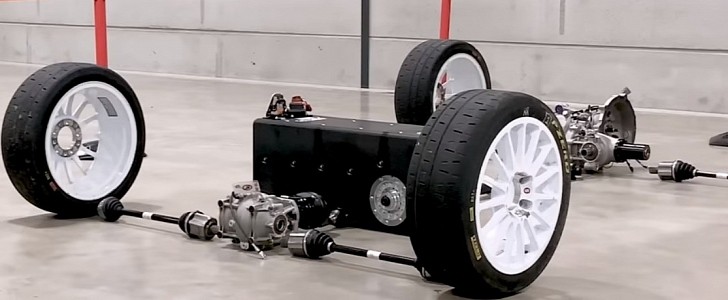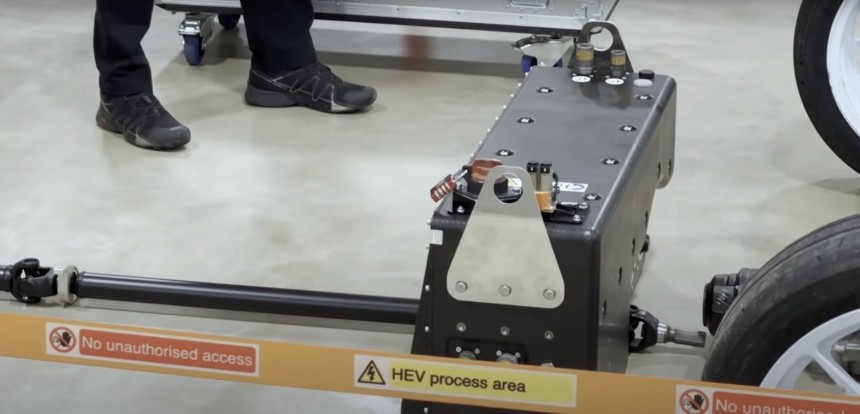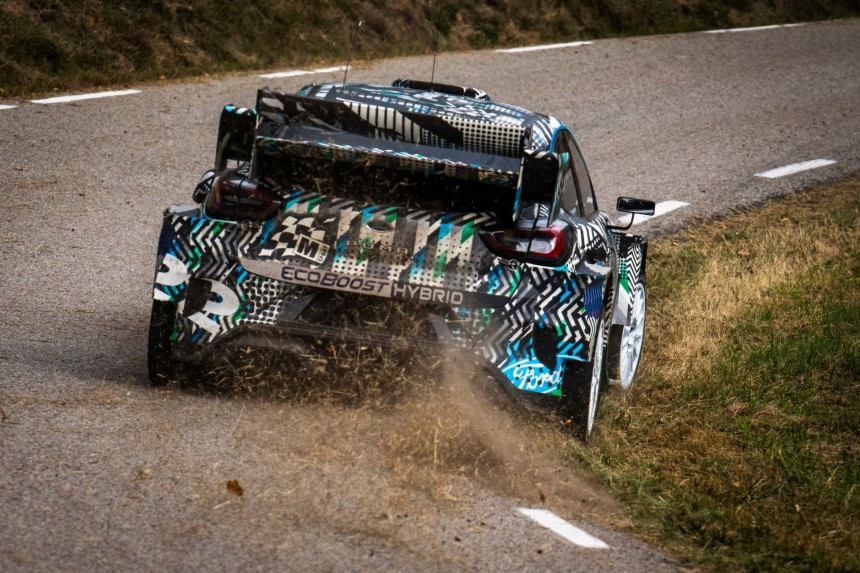The new racing cars of the top class of the World Rally Championship will be hybrids for the first time ever. As their first race approaches, we learn more about their characteristics. While some of them could be understood from the rules, M-Sport goes further and shows us what's underneath their bodies.
The plug-in hybrid, and essentially, the hybrid era of the World Rally Championship cars was supposed to start earlier, but it was delayed because of the pandemic. The idea was to have drivers competing in the top tier of the sport with the latest technology available in road-going cars, but with limited development costs.
In the interest of the latter, the rules mandate that last year's 1.6-liter turbocharged gasoline engines are here to stay, but they now come with a five-speed sequential transmission instead of the paddle-shifted six-speed unit that was employed before. The transmission is set to be close to the one found in the Rally2 class.
Another important change is the elimination of the center differential, which will change how the new vehicles behave on the limit. The skill of each driver, along with their ability to adapt to a new car, will make the difference.
Since the central diff was eliminated and so was the paddle-shifted gearbox, the hydraulic system of the previous generation of WRC cars has been eliminated.
Now, WRC cars of the Rally1 class, which is the top tier of the sport, will be shifted with the lever that is in front of the center console, like what you might find in a regular car.
The transmission does support clutch-less shifting for every gear except first and reverse, and the latter needs to be activated by pressing a button, which prevents the driver from going lower than first gear accidentally. Many, if not all rally cars (and racing cars in other series) have a protection system in place to prevent the driver from going into reverse from first gear. In many cases, there is a button on the shift leaver that needs to be pressed to allow going to Neutral and then to Reverse.
Even though the new rally cars are plug-in hybrids, their driveshafts still go all the way from the front to the rear axle, which means that the combustion engine will still power the rear wheels. The latter is also powered by the electric motor that is integrated with its battery in a sealed carbon fiber box.
The electric motor delivers its resources to the rear wheels through a separate driveshaft that connects to the rear differential. The one seen in the video below, as well as in the photo gallery, is one from the Rally2 class of vehicles, and we are told that the unit is different from the Rally1 models.
Mind you, the rear differential has to be different, as it gets two driveshaft inputs that need to be managed while still having two driveshaft outputs, along with its limited-slip and other key features.
The latter is identical between all rally cars of the Rally1 class, and each team has two units available for each vehicle for every race. The hybrid system allows the crews to drive up to five kilometers (ca. 3.1 miles) on electric power alone, but the current rules for the first race of the season require a much smaller minimum distance that needs to be traveled on electric power alone.
With the full assistance of the hybrid system, the new Rally1 racing cars provide around 530 horsepower of combined output. The Motor-Generator unit with integrated battery weighs 100 kilograms (ca. 220 lbs.) and is placed on the rear axle, while it can deliver up to 100 KW of power (ca. 136 horsepower).
The FIA will mandate how much power boost the system can deliver on each stage of the race and on each "boost event," and this is one of the things that is non-negotiable with teams. The latter can employ their ECU settings, as regulations allow, but that is it. The rules say that the battery must “last” the entire stage, which means less e-boost on longer stages, and more on shorter stages.
Upon completion of the timed rally stage, the battery will still have energy left in it, even as high as 30 percent, as Tim Jackson, M-Sport Lead Development Engineer, explains in a video about the 2022 Ford Puma Hybrid Rally1 racecar.
In other words, longer stages will mean that the overall power of the system will not reach the described peak, of 530 horsepower for brief moments, but shorter stages will mean that the new race cars will be as close to Group B as possible when power and torque are concerned. They will be in a class of their own when safety is concerned, and grip, as well as aerodynamics, are significantly more advanced.
The ECU will decide the balance of the hybrid system, which means that the internal combustion engine will do most of the work. On the way to the timed stage, the driver will make use of the ICE to charge the hybrid system's battery, up to a maximum of 80 percent, so that full power is available at the start line.
When starting on a timed rally stage, you can expect all Rally1 models to benefit from their maximum output off the line, within the limits of tire grip and weather conditions. Just like in production hybrids, the battery is charged each time the brake is pressed.
The new plug-in hybrid drivetrain of the WRC cars has been developed and produced by a third-party company called Compact Dynamics. This way, development costs have been reduced and capped, and no team gets an extra advantage out of its system. It does limit the potential for new developments in the field, but those rarely reach production vehicles anyway.
It is also worth noting that the plug-in hybrid system will have its battery charged in every service park of each event from a dedicated charger.
The latter will charge it for 30 to 45 minutes, but not necessarily to its full capacity, as it only needs to be able to enter and exit the service park on electric power alone if nothing is broken.
The charging part of the hybrid drivetrain is supposed to happen on the road to the next timed stage, which means that the internal combustion mill is used as a generator by the 100-KW e-motor. This will mean that crews will also have more math to do on the road, as they need to calculate their state of charge when reaching a stage start line, not just their remaining fuel level.
In the interest of the latter, the rules mandate that last year's 1.6-liter turbocharged gasoline engines are here to stay, but they now come with a five-speed sequential transmission instead of the paddle-shifted six-speed unit that was employed before. The transmission is set to be close to the one found in the Rally2 class.
Another important change is the elimination of the center differential, which will change how the new vehicles behave on the limit. The skill of each driver, along with their ability to adapt to a new car, will make the difference.
Since the central diff was eliminated and so was the paddle-shifted gearbox, the hydraulic system of the previous generation of WRC cars has been eliminated.
Now, WRC cars of the Rally1 class, which is the top tier of the sport, will be shifted with the lever that is in front of the center console, like what you might find in a regular car.
The transmission does support clutch-less shifting for every gear except first and reverse, and the latter needs to be activated by pressing a button, which prevents the driver from going lower than first gear accidentally. Many, if not all rally cars (and racing cars in other series) have a protection system in place to prevent the driver from going into reverse from first gear. In many cases, there is a button on the shift leaver that needs to be pressed to allow going to Neutral and then to Reverse.
Even though the new rally cars are plug-in hybrids, their driveshafts still go all the way from the front to the rear axle, which means that the combustion engine will still power the rear wheels. The latter is also powered by the electric motor that is integrated with its battery in a sealed carbon fiber box.
Mind you, the rear differential has to be different, as it gets two driveshaft inputs that need to be managed while still having two driveshaft outputs, along with its limited-slip and other key features.
The latter is identical between all rally cars of the Rally1 class, and each team has two units available for each vehicle for every race. The hybrid system allows the crews to drive up to five kilometers (ca. 3.1 miles) on electric power alone, but the current rules for the first race of the season require a much smaller minimum distance that needs to be traveled on electric power alone.
With the full assistance of the hybrid system, the new Rally1 racing cars provide around 530 horsepower of combined output. The Motor-Generator unit with integrated battery weighs 100 kilograms (ca. 220 lbs.) and is placed on the rear axle, while it can deliver up to 100 KW of power (ca. 136 horsepower).
The FIA will mandate how much power boost the system can deliver on each stage of the race and on each "boost event," and this is one of the things that is non-negotiable with teams. The latter can employ their ECU settings, as regulations allow, but that is it. The rules say that the battery must “last” the entire stage, which means less e-boost on longer stages, and more on shorter stages.
Upon completion of the timed rally stage, the battery will still have energy left in it, even as high as 30 percent, as Tim Jackson, M-Sport Lead Development Engineer, explains in a video about the 2022 Ford Puma Hybrid Rally1 racecar.
In other words, longer stages will mean that the overall power of the system will not reach the described peak, of 530 horsepower for brief moments, but shorter stages will mean that the new race cars will be as close to Group B as possible when power and torque are concerned. They will be in a class of their own when safety is concerned, and grip, as well as aerodynamics, are significantly more advanced.
When starting on a timed rally stage, you can expect all Rally1 models to benefit from their maximum output off the line, within the limits of tire grip and weather conditions. Just like in production hybrids, the battery is charged each time the brake is pressed.
The new plug-in hybrid drivetrain of the WRC cars has been developed and produced by a third-party company called Compact Dynamics. This way, development costs have been reduced and capped, and no team gets an extra advantage out of its system. It does limit the potential for new developments in the field, but those rarely reach production vehicles anyway.
It is also worth noting that the plug-in hybrid system will have its battery charged in every service park of each event from a dedicated charger.
The latter will charge it for 30 to 45 minutes, but not necessarily to its full capacity, as it only needs to be able to enter and exit the service park on electric power alone if nothing is broken.
The charging part of the hybrid drivetrain is supposed to happen on the road to the next timed stage, which means that the internal combustion mill is used as a generator by the 100-KW e-motor. This will mean that crews will also have more math to do on the road, as they need to calculate their state of charge when reaching a stage start line, not just their remaining fuel level.

























